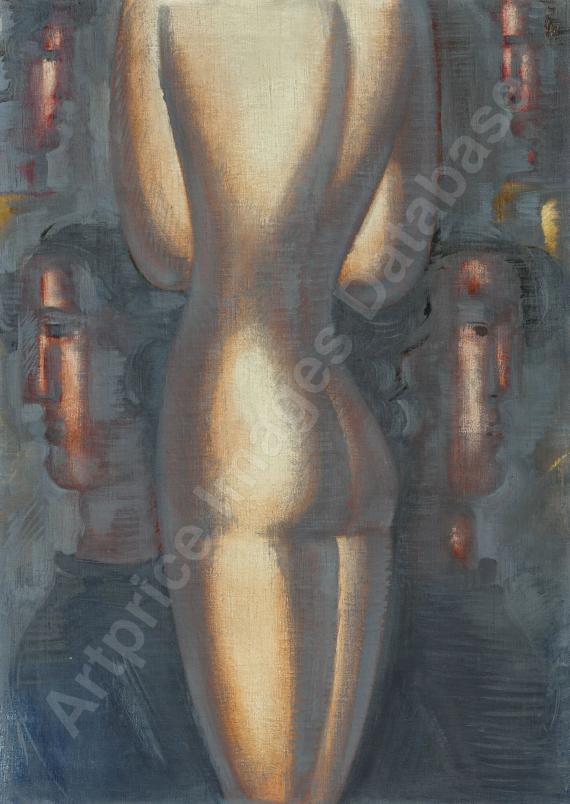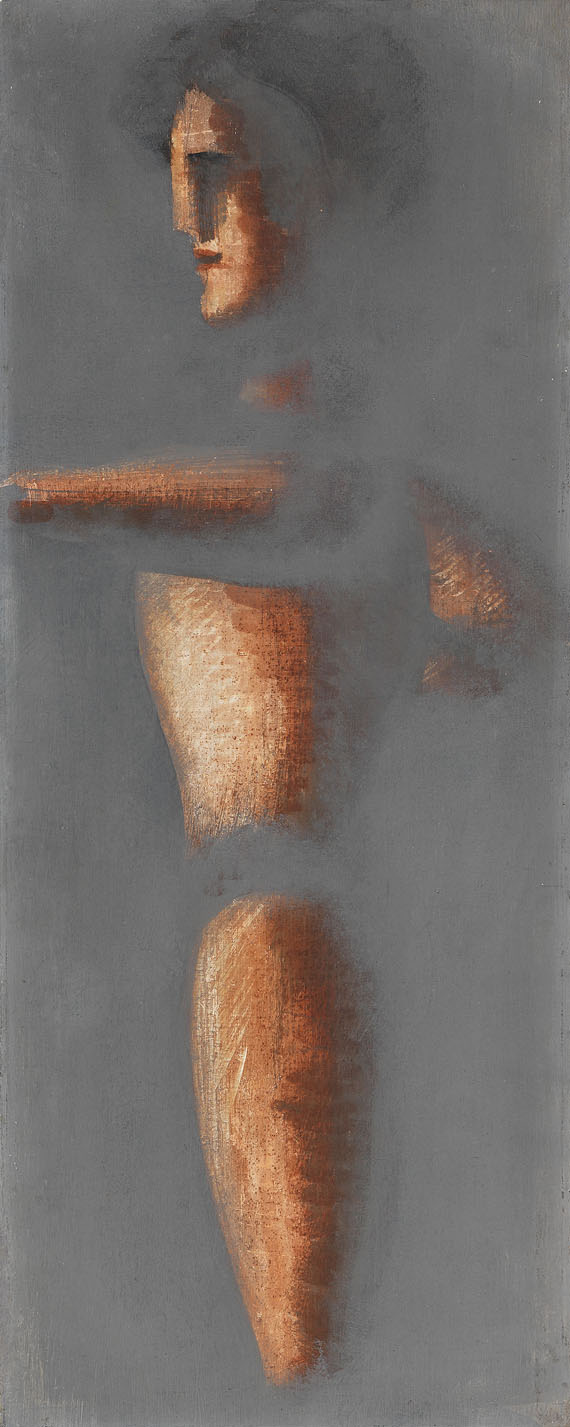Video
Frame image
78
Oskar Schlemmer
Jünglingsgruppe in Braun, 1928.
Synthetic resin on nettle and on panel
Estimate:
€ 280,000 - 350,000
$ 324,800 - 406,000
Oskar Schlemmer
1888 - 1943
Jünglingsgruppe in Braun. 1928.
Synthetic resin on nettle and on panel.
Signed, dated "Dez. 1928", titled"Jünglingsgruppe in braun" and inscribed "Sperrholz" on the reverse. 69.5 x 30.2 cm (27.3 x 11.8 in).
Preliminary work for the murals at the Museum Folkwang, Essen. Related studies: cf. Karin v. Maur, Oskar Schlemmer, vol. II, catalog of paintings, watercolors, pastels, and sculptures, Munich 1979, CR nos. G 167, G 170, which lead to image 4 of the first version, G 177. For accompanying pencil sketches, cf.: Will Grohmann u. Tut Schlemmer, Stuttgart 1965, CR nos. 228 and 229 (illustrated on p. 248). [CH].
• Figure in space: The arrangement of heads and profiles on different levels culminates in the “Bauhaus Staircase” (1932, MoMA, New York), a few years later.
• Masterful orchestration of light and shadow, depth effect, and plasticity.
• “Jünglingsgruppe in Braun" (Group of Young Men in Brown) was created in the context of the destroyed murals in the Museum Folkwang, Essen.
• Schlemmer’s figure compositions from the Bauhaus years are considered the artist’s most sought-after works on the international auction market.
• In 1930, Schlemmer's works were part of the XVII Biennale in Venice, and in 1931, he was represented in the major retrospective “Modern German Painting and Sculpture” at the Museum of Modern Art in New York.
• First exhibited in 1929 and part of an acclaimed private collection in Berlin for 45 years.
We are grateful to Mr. C. Raman Schlemmer, The Oskar Schlemmer Estate + Archives, for his kind expert advice.
We are grateful to Mr. Markus H. Stötzel and the heirs of Alfred Flechtheim for their kind expert advice.
PROVENANCE: Collection of Dipl. Ing. Karl Wilhelm Zachrich, Freiburg i. Br. (acquired in 1946).
“Dr. Kr.” (until 1950).
Galerie Limmer, Freiburg (1978).
Private collection, Wuppertal.
Galerie Linssen, Bonn.
Private collection, Berlin (acquired from the above in 1980).
EXHIBITION: Stuttgarter Neue Sezession, Kunsthaus Schaller, Stuttgart 1929, list no. 5 (with handwritten label on the reverse, there inscribed with no. 153).
Bauhaus Dessau, Kunsthalle Basel, April 20–May 9, 1929, p. 10, cat. no. 141 (with the title “Jünglinge” and the designation “Freskostudie,” on the artist's list for this exhibition inscribed “Fresko-Studie IV”).
Oskar Schlemmer, Kunsthaus Schaller, Stuttgart, May to June 1929, list no. 5, (verso with handwritten label: “135 Prof. O. Schlemmer / JÜnglingsfiguren in braun”)
Gemälde, Graphik, Plastik, Architektur, Kunstgewerbe, Staatliche Akademie für Kunst und Kunstgewerbe, Wroclaw, January 18–February 19, 1930, probably p. 15, no. 20 (with the title “Fresko-Studie D”).
Oskar Schlemmer, Galerie Flechtheim, Berlin, 1931, list no. 34 (not in catalog).
Moderne Kunst aus Freiburger Privatbesitz, Stadthalle, Freiburg i. Br., March 12–April 3, 1960, cat. no. 70.
Kunst des 20. Jahrhunderts, Galerie Linssen, Bonn, April to June 1980 (with the stamp on the reverse)
Oskar Schlemmer: Der Folkwang-Zyklus. Malerei um 1930, Staatsgalerie Stuttgart, September 11–November 14, 1993; Museum Folkwang Essen, December 13, 1993–February 14, 1994, pp. 158 and 169, cat. no. 151 (illustrated on p. 169, with the label on the frame).
LITERATURE: Karin v. Maur, Oskar Schlemmer, Vol. II, Oeuvre catalog of paintings, watercolors, pastels, and sculptures, Munich 1979, p. 76, CR no. G 169 ( illustrated in black and white on p. 77).
Hans Hildebrandt, Oskar Schlemmer, Munich 1952, CR no. 147.
- -
Kunsthaus Pfisterer, I. Große Freiburger Kunst-Auktion, Freiburg im Breisgau, March 22/23, 1950, lot 557.
Called up: December 5, 2025 - ca. 19.34 h +/- 20 min.
1888 - 1943
Jünglingsgruppe in Braun. 1928.
Synthetic resin on nettle and on panel.
Signed, dated "Dez. 1928", titled"Jünglingsgruppe in braun" and inscribed "Sperrholz" on the reverse. 69.5 x 30.2 cm (27.3 x 11.8 in).
Preliminary work for the murals at the Museum Folkwang, Essen. Related studies: cf. Karin v. Maur, Oskar Schlemmer, vol. II, catalog of paintings, watercolors, pastels, and sculptures, Munich 1979, CR nos. G 167, G 170, which lead to image 4 of the first version, G 177. For accompanying pencil sketches, cf.: Will Grohmann u. Tut Schlemmer, Stuttgart 1965, CR nos. 228 and 229 (illustrated on p. 248). [CH].
• Figure in space: The arrangement of heads and profiles on different levels culminates in the “Bauhaus Staircase” (1932, MoMA, New York), a few years later.
• Masterful orchestration of light and shadow, depth effect, and plasticity.
• “Jünglingsgruppe in Braun" (Group of Young Men in Brown) was created in the context of the destroyed murals in the Museum Folkwang, Essen.
• Schlemmer’s figure compositions from the Bauhaus years are considered the artist’s most sought-after works on the international auction market.
• In 1930, Schlemmer's works were part of the XVII Biennale in Venice, and in 1931, he was represented in the major retrospective “Modern German Painting and Sculpture” at the Museum of Modern Art in New York.
• First exhibited in 1929 and part of an acclaimed private collection in Berlin for 45 years.
We are grateful to Mr. C. Raman Schlemmer, The Oskar Schlemmer Estate + Archives, for his kind expert advice.
We are grateful to Mr. Markus H. Stötzel and the heirs of Alfred Flechtheim for their kind expert advice.
PROVENANCE: Collection of Dipl. Ing. Karl Wilhelm Zachrich, Freiburg i. Br. (acquired in 1946).
“Dr. Kr.” (until 1950).
Galerie Limmer, Freiburg (1978).
Private collection, Wuppertal.
Galerie Linssen, Bonn.
Private collection, Berlin (acquired from the above in 1980).
EXHIBITION: Stuttgarter Neue Sezession, Kunsthaus Schaller, Stuttgart 1929, list no. 5 (with handwritten label on the reverse, there inscribed with no. 153).
Bauhaus Dessau, Kunsthalle Basel, April 20–May 9, 1929, p. 10, cat. no. 141 (with the title “Jünglinge” and the designation “Freskostudie,” on the artist's list for this exhibition inscribed “Fresko-Studie IV”).
Oskar Schlemmer, Kunsthaus Schaller, Stuttgart, May to June 1929, list no. 5, (verso with handwritten label: “135 Prof. O. Schlemmer / JÜnglingsfiguren in braun”)
Gemälde, Graphik, Plastik, Architektur, Kunstgewerbe, Staatliche Akademie für Kunst und Kunstgewerbe, Wroclaw, January 18–February 19, 1930, probably p. 15, no. 20 (with the title “Fresko-Studie D”).
Oskar Schlemmer, Galerie Flechtheim, Berlin, 1931, list no. 34 (not in catalog).
Moderne Kunst aus Freiburger Privatbesitz, Stadthalle, Freiburg i. Br., March 12–April 3, 1960, cat. no. 70.
Kunst des 20. Jahrhunderts, Galerie Linssen, Bonn, April to June 1980 (with the stamp on the reverse)
Oskar Schlemmer: Der Folkwang-Zyklus. Malerei um 1930, Staatsgalerie Stuttgart, September 11–November 14, 1993; Museum Folkwang Essen, December 13, 1993–February 14, 1994, pp. 158 and 169, cat. no. 151 (illustrated on p. 169, with the label on the frame).
LITERATURE: Karin v. Maur, Oskar Schlemmer, Vol. II, Oeuvre catalog of paintings, watercolors, pastels, and sculptures, Munich 1979, p. 76, CR no. G 169 ( illustrated in black and white on p. 77).
Hans Hildebrandt, Oskar Schlemmer, Munich 1952, CR no. 147.
- -
Kunsthaus Pfisterer, I. Große Freiburger Kunst-Auktion, Freiburg im Breisgau, March 22/23, 1950, lot 557.
Called up: December 5, 2025 - ca. 19.34 h +/- 20 min.
The “measure of all things”: The new man and the figure in space
Oskar Schlemmer is recognized as one of the most influential and versatile artists of the Bauhaus: during his time in Weimar (1921–1925) and Dessau (1925–1929), he worked not only as a painter, draftsman, and graphic artist, but also as a sculptor, stage designer, choreographer, and theorist. As early as 1921, Schlemmer took over management of the stone and wood sculpture department as ‘form master’, teaching nude and figure drawing and also serving as artistic director of mural painting – a form of design that he was to become highly involved in over the following years.
After moving to Dessau, Schlemmer assumed responsibility for the Bauhaus stage and, from 1928, taught the subject “The Human Being.” His art began to revolve almost exclusively around the depiction of the human head and body. Renouncing individual characteristics, the artist developed highly stylized, harmoniously composed figure studies with strictly aligned vertical and horizontal axes based on geometric body language and form. He elevated the human being to the core of his experimental work and to the “measure of all things”: "Nevertheless, one great theme remained, ancient, eternally new, the subject and creator of all times: the human being, the human figure. It is said that he is the measure of all things. Well then! Architecture is the noblest art of measurement, join forces!" (Oskar Schlemmer, Diary, July/August 1923, quoted from: Exhibition catalog Oskar Schlemmer. Visionen einer neuen Welt, Munich 2014, p. 157)

Drawings, sketches, paintings: the “Folkwang Cycle”
Driven by this desire to merge art and architecture, Schlemmer's artistic projects increasingly shifted towards sculpture, wall reliefs, and, of course, murals.
In October 1928, the artist was commissioned by the then museum director Ernst Gosebruch to design the walls of a small rotunda in the new Museum Folkwang in Essen, which had opened in 1922. The white marble fountain created by Georg Minne, located in the very center of the rotunda, was now to be surrounded by young German contemporary art. Instead of the fresco technique initially suggested, it was agreed that nine large panels, each measuring 2.50 x 1.65 meters, would be created for the lower walls of the rotunda. The commission occupied Schlemmer in a complex, multi-phase creative process over three years and, in retrospect, reveals a crucial stylistic change in the artist's work: away from the strictly tectonic Bauhaus images to the looser, liberated style of his later years in Wrocław.
Ultimately, three complete full-size versions were created, as well as numerous sketches, preliminary studies, variants, and paintings closely related to the series shown in Essen, including this work “Jünglingsgruppe in Braun” (Group of Young Men in Brown), which the author of the catalogue raisonné, Karin v. Maur, counts among the preliminary works for the first version created between October 1928 and April 1929 and which, alongside other closely related paintings (cf. CR G 167, whereabouts unknown, G 168 and G 170, whereabouts unknown) ultimately culminates in picture 4 (CR G 177) of the first version of the Folkwang cycle, today housed at the Staatsgalerie Stuttgart.
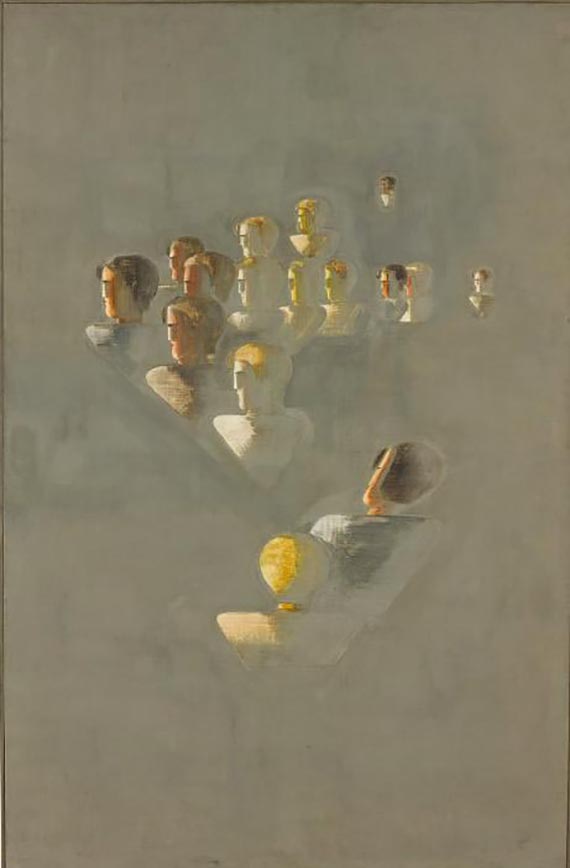
“Jüngglingsgruppe in Braun”: light and shadow – pause and movement
This first version consists of four individual figures and five multi-figure depictions that vary the heads and half-figures in rhythmic sequences. To avoid cluttering the space, Schlemmer sought simplicity in both the technique and the quantity of his painting, depicting his cubic bodies with his usual statuesque, stylized austerity.
Thus, the figures in “Jüngglingsgruppe in Braun” are exclusively composed of rounded shapes, with faces and limbs reduced to soft and straightforward features, as well as shadowy silhouettes.
The artist shows strongly cropped heads, fragmentarily and almost solely in profile, without reference to an actual location, so that figures and space merge to some extent. A little “light” playfully illuminates the stage-like scene from the left, bathing the figures in contrasting light and shadow.
While the majority of the figures facing left appear motionless, the lower and upper figures, with their slanted positions and distance, convey a sense of spatiality, depth, and movement. In addition, Schlemmer clearly places the figures at different heights within the space—a choreographed arrangement of heads and profiles on various levels, which a few years later culminated in the “ Zwölfergruppe mit Interieur (Group of Twelve with Interior)” (1930, Von der Heydt Museum, Wuppertal), but especially in the “Bauhaus Staircase” (1932, Museum of Modern Art, New York).
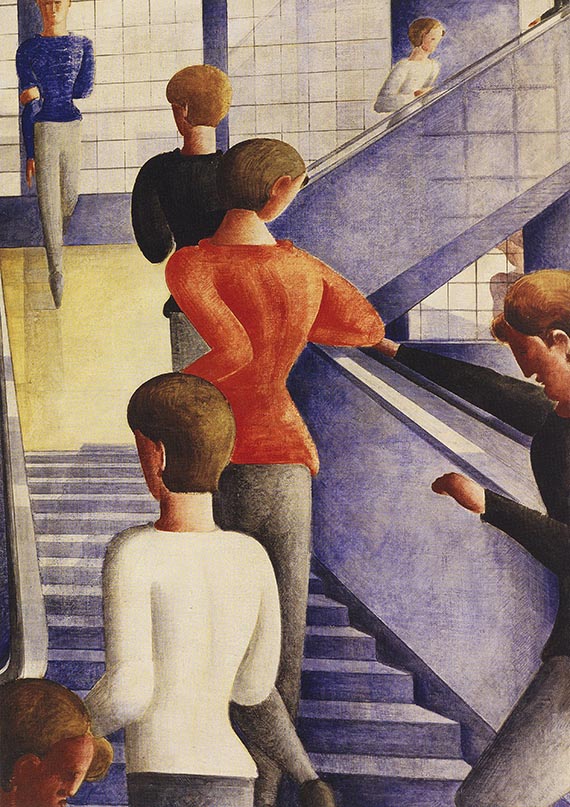
Rise and fall
The political situation in Germany and Europe as a whole tipped in these years. The effects of the National Socialists' gradual takeover of power and influence increasingly affected Oskar Schlemme as well. In 1930, the mural he had created for the Weimar Bauhaus exhibition in 1923 was destroyed on the orders of the Nazi government, numerous of his works were removed from German museums, and some were defamed in the 1937 exhibition “Degenerate Art” in Munich. After they were removed from the museum walls and stored in a warehouse in 1933, his murals from the Folkwang cycle are also presumed lost today. Schlemmer's career finally came to a complete standstill.
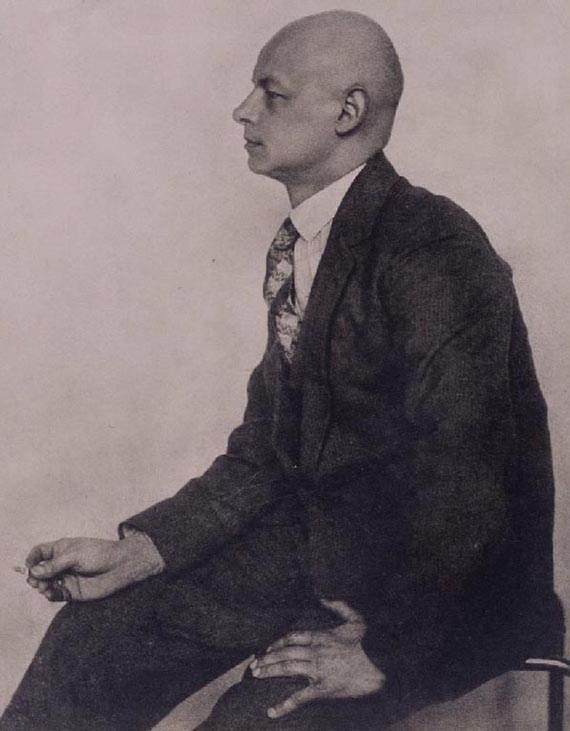
The creative vision of a great artist
In his endeavors to create a holistically educated society and to combine craftsmanship and artistic creativity across genres, his impressive oeuvre fully embodies the spirit and ideals of the Bauhaus, which had a formative influence on design and art throughout the first half of the 20th century. For Walter Gropius, architect and founder of the Bauhaus, Schlemmer's significant contribution to art and his significance for Modernism remain undisputed: "Oscar Schlemmer's paintings embody a new spatial energy that has always held a magic allure for me. His architectural interpretation within a painted space is unique and must stem from a profound experience of space itself. It creates a premonition of a future culture of wholeness in the viewer's mind, a culture that reunites the arts. For me, the work reveals the creative vision of a great artist that lives on even though its creator has died." (Walter Gropius, 1953, quoted from: Exhibition catalog Oskar Schlemmer. Das Bauhaus und der Weg in die Moderne, Stuttgart 2019, p. 24) [CH]
After he had won the contest for the mural design in the fountain room of the Museum Folkwang, Schlemmer experimented with various techniques in 1928. In this context, he referred to the studies, which were initially executed on nettle or canvas, as “fresco studies.” The designs and paintings were created in his studio in the Meisterhaus at the Bauhaus Dessau; the present painting was completed in December 1928. He created the entire cycle—including the third, final, and installed version from 1930—on canvas and mounted it on plywood panels, although not as a fresco.
When the artist sent the studies to exhibitions in 1929, 1930, and 1931, he referred to them on his lists as fresco studies, labeling them with the letters A to D or Roman numerals. Hoping to sell them as independent paintings in galleries, Schlemmer labeled the reverse side of the smaller oil paintings independent titles that no longer had any direct connection to the Folkwang cycle.
During the artist's lifetime, his paintings for the Folkwang cycle were exhibited at the XVII Biennale in Venice in 1930, and in the first exhibition of German avant-garde art, “Modern German Painting and Sculpture,” at the Museum of Modern Art in New York in 1931 (catalog p. 34 with an accompanying essay).
Many of these panels, including those from the 1928 version and the entire 1930 version, were confiscated by the National Socialists in 1937 as part of the “Degenerate Art” campaign and are believed to have been lost or destroyed.
© 2025 C. Raman Schlemmer
Oskar Schlemmer is recognized as one of the most influential and versatile artists of the Bauhaus: during his time in Weimar (1921–1925) and Dessau (1925–1929), he worked not only as a painter, draftsman, and graphic artist, but also as a sculptor, stage designer, choreographer, and theorist. As early as 1921, Schlemmer took over management of the stone and wood sculpture department as ‘form master’, teaching nude and figure drawing and also serving as artistic director of mural painting – a form of design that he was to become highly involved in over the following years.
After moving to Dessau, Schlemmer assumed responsibility for the Bauhaus stage and, from 1928, taught the subject “The Human Being.” His art began to revolve almost exclusively around the depiction of the human head and body. Renouncing individual characteristics, the artist developed highly stylized, harmoniously composed figure studies with strictly aligned vertical and horizontal axes based on geometric body language and form. He elevated the human being to the core of his experimental work and to the “measure of all things”: "Nevertheless, one great theme remained, ancient, eternally new, the subject and creator of all times: the human being, the human figure. It is said that he is the measure of all things. Well then! Architecture is the noblest art of measurement, join forces!" (Oskar Schlemmer, Diary, July/August 1923, quoted from: Exhibition catalog Oskar Schlemmer. Visionen einer neuen Welt, Munich 2014, p. 157)

Oskar Schlemmer, the Weimar Bauhaus emblem, 1922, Oskar Schlemmer Archive.
Drawings, sketches, paintings: the “Folkwang Cycle”
Driven by this desire to merge art and architecture, Schlemmer's artistic projects increasingly shifted towards sculpture, wall reliefs, and, of course, murals.
In October 1928, the artist was commissioned by the then museum director Ernst Gosebruch to design the walls of a small rotunda in the new Museum Folkwang in Essen, which had opened in 1922. The white marble fountain created by Georg Minne, located in the very center of the rotunda, was now to be surrounded by young German contemporary art. Instead of the fresco technique initially suggested, it was agreed that nine large panels, each measuring 2.50 x 1.65 meters, would be created for the lower walls of the rotunda. The commission occupied Schlemmer in a complex, multi-phase creative process over three years and, in retrospect, reveals a crucial stylistic change in the artist's work: away from the strictly tectonic Bauhaus images to the looser, liberated style of his later years in Wrocław.
Ultimately, three complete full-size versions were created, as well as numerous sketches, preliminary studies, variants, and paintings closely related to the series shown in Essen, including this work “Jünglingsgruppe in Braun” (Group of Young Men in Brown), which the author of the catalogue raisonné, Karin v. Maur, counts among the preliminary works for the first version created between October 1928 and April 1929 and which, alongside other closely related paintings (cf. CR G 167, whereabouts unknown, G 168 and G 170, whereabouts unknown) ultimately culminates in picture 4 (CR G 177) of the first version of the Folkwang cycle, today housed at the Staatsgalerie Stuttgart.

Oskar Schlemmer, Unterricht III, 1929, oil and tempera on canvas, Staatsgalerie Stuttgart.
“Jüngglingsgruppe in Braun”: light and shadow – pause and movement
This first version consists of four individual figures and five multi-figure depictions that vary the heads and half-figures in rhythmic sequences. To avoid cluttering the space, Schlemmer sought simplicity in both the technique and the quantity of his painting, depicting his cubic bodies with his usual statuesque, stylized austerity.
Thus, the figures in “Jüngglingsgruppe in Braun” are exclusively composed of rounded shapes, with faces and limbs reduced to soft and straightforward features, as well as shadowy silhouettes.
The artist shows strongly cropped heads, fragmentarily and almost solely in profile, without reference to an actual location, so that figures and space merge to some extent. A little “light” playfully illuminates the stage-like scene from the left, bathing the figures in contrasting light and shadow.
While the majority of the figures facing left appear motionless, the lower and upper figures, with their slanted positions and distance, convey a sense of spatiality, depth, and movement. In addition, Schlemmer clearly places the figures at different heights within the space—a choreographed arrangement of heads and profiles on various levels, which a few years later culminated in the “ Zwölfergruppe mit Interieur (Group of Twelve with Interior)” (1930, Von der Heydt Museum, Wuppertal), but especially in the “Bauhaus Staircase” (1932, Museum of Modern Art, New York).

Oskar Schlemmer, Bauhaustreppe, 1932, oil on canvas, Museum of Modern Art, New York.
Rise and fall
The political situation in Germany and Europe as a whole tipped in these years. The effects of the National Socialists' gradual takeover of power and influence increasingly affected Oskar Schlemme as well. In 1930, the mural he had created for the Weimar Bauhaus exhibition in 1923 was destroyed on the orders of the Nazi government, numerous of his works were removed from German museums, and some were defamed in the 1937 exhibition “Degenerate Art” in Munich. After they were removed from the museum walls and stored in a warehouse in 1933, his murals from the Folkwang cycle are also presumed lost today. Schlemmer's career finally came to a complete standstill.

Oskar Schlemmer, 1920, vintage print, Museum Folkwang, Essen, photo: Hugo Erfurth.
The creative vision of a great artist
In his endeavors to create a holistically educated society and to combine craftsmanship and artistic creativity across genres, his impressive oeuvre fully embodies the spirit and ideals of the Bauhaus, which had a formative influence on design and art throughout the first half of the 20th century. For Walter Gropius, architect and founder of the Bauhaus, Schlemmer's significant contribution to art and his significance for Modernism remain undisputed: "Oscar Schlemmer's paintings embody a new spatial energy that has always held a magic allure for me. His architectural interpretation within a painted space is unique and must stem from a profound experience of space itself. It creates a premonition of a future culture of wholeness in the viewer's mind, a culture that reunites the arts. For me, the work reveals the creative vision of a great artist that lives on even though its creator has died." (Walter Gropius, 1953, quoted from: Exhibition catalog Oskar Schlemmer. Das Bauhaus und der Weg in die Moderne, Stuttgart 2019, p. 24) [CH]
After he had won the contest for the mural design in the fountain room of the Museum Folkwang, Schlemmer experimented with various techniques in 1928. In this context, he referred to the studies, which were initially executed on nettle or canvas, as “fresco studies.” The designs and paintings were created in his studio in the Meisterhaus at the Bauhaus Dessau; the present painting was completed in December 1928. He created the entire cycle—including the third, final, and installed version from 1930—on canvas and mounted it on plywood panels, although not as a fresco.
When the artist sent the studies to exhibitions in 1929, 1930, and 1931, he referred to them on his lists as fresco studies, labeling them with the letters A to D or Roman numerals. Hoping to sell them as independent paintings in galleries, Schlemmer labeled the reverse side of the smaller oil paintings independent titles that no longer had any direct connection to the Folkwang cycle.
During the artist's lifetime, his paintings for the Folkwang cycle were exhibited at the XVII Biennale in Venice in 1930, and in the first exhibition of German avant-garde art, “Modern German Painting and Sculpture,” at the Museum of Modern Art in New York in 1931 (catalog p. 34 with an accompanying essay).
Many of these panels, including those from the 1928 version and the entire 1930 version, were confiscated by the National Socialists in 1937 as part of the “Degenerate Art” campaign and are believed to have been lost or destroyed.
© 2025 C. Raman Schlemmer
78
Oskar Schlemmer
Jünglingsgruppe in Braun, 1928.
Synthetic resin on nettle and on panel
Estimate:
€ 280,000 - 350,000
$ 324,800 - 406,000
Buyer's premium and taxation for Oskar Schlemmer "Jünglingsgruppe in Braun"
This lot can be purchased subject to differential or regular taxation.
Differential taxation:
Hammer price up to 1,000,000 €: herefrom 34 % premium.
The share of the hammer price exceeding 1,000,000 € is subject to a premium of 29 % and is added to the premium of the share of the hammer price up to 1,000,000 €.
The share of the hammer price exceeding 4,000,000 € is subject to a premium of 22 % and is added to the premium of the share of the hammer price up to 4,000,000 €.
The buyer's premium contains VAT, however, it is not shown.
Regular taxation:
Hammer price up to 1,000,000 €: herefrom 29 % premium.
The share of the hammer price exceeding 1,000,000 € is subject to a premium of 23% and is added to the premium of the share of the hammer price up to 1,000,000 €.
The share of the hammer price exceeding 4,000,000 € is subject to a premium of 15% and is added to the premium of the share of the hammer price up to 4,000,000 €.
The statutory VAT of currently 7 % is levied to the sum of hammer price and premium.
We kindly ask you to notify us before invoicing if you wish to be subject to regular taxation.
Differential taxation:
Hammer price up to 1,000,000 €: herefrom 34 % premium.
The share of the hammer price exceeding 1,000,000 € is subject to a premium of 29 % and is added to the premium of the share of the hammer price up to 1,000,000 €.
The share of the hammer price exceeding 4,000,000 € is subject to a premium of 22 % and is added to the premium of the share of the hammer price up to 4,000,000 €.
The buyer's premium contains VAT, however, it is not shown.
Regular taxation:
Hammer price up to 1,000,000 €: herefrom 29 % premium.
The share of the hammer price exceeding 1,000,000 € is subject to a premium of 23% and is added to the premium of the share of the hammer price up to 1,000,000 €.
The share of the hammer price exceeding 4,000,000 € is subject to a premium of 15% and is added to the premium of the share of the hammer price up to 4,000,000 €.
The statutory VAT of currently 7 % is levied to the sum of hammer price and premium.
We kindly ask you to notify us before invoicing if you wish to be subject to regular taxation.
Headquarters
Joseph-Wild-Str. 18
81829 Munich
Phone: +49 89 55 244-0
Fax: +49 89 55 244-177
info@kettererkunst.de
Louisa von Saucken / Undine Schleifer
Holstenwall 5
20355 Hamburg
Phone: +49 40 37 49 61-0
Fax: +49 40 37 49 61-66
infohamburg@kettererkunst.de
Dr. Simone Wiechers / Nane Schlage
Fasanenstr. 70
10719 Berlin
Phone: +49 30 88 67 53-63
Fax: +49 30 88 67 56-43
infoberlin@kettererkunst.de
Cordula Lichtenberg
Gertrudenstraße 24-28
50667 Cologne
Phone: +49 221 510 908-15
infokoeln@kettererkunst.de
Hessen
Rhineland-Palatinate
Miriam Heß
Phone: +49 62 21 58 80-038
Fax: +49 62 21 58 80-595
infoheidelberg@kettererkunst.de
We will inform you in time.




 Lot 78
Lot 78 


